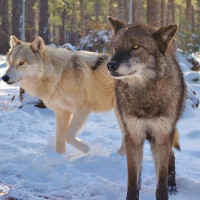 |
Alaskan Tundra Wolf |
|
He is a wild animal |
Origin |
Alaska | |
Translation |
Francis Vandersteen |
| The possession of this animal is not authorized Royal Decree establishing the list of mammals not kept for production purposes that may be kept (M.B. 24.08.2009) |
| The Canis lupus tundrarum was identified as a subspecies in 1912 by zoologist Gerrit Smith Miller. Some believe it is simply an extension of the Alaskan Interior Wolf, while others think it is the Mackenzie Valley or Mackenzie Tundra Wolf. The Alaskan Tundra Wolf shares many characteristics with all three. The Alaskan Tundra Wolf resides in the tundra regions along the arctic coast of northern Alaska. The Alaskan Tundra wolf is a large wolf measuring 1.25 to 1.62 m in length (nose to tail). Weights range from 38.5 to 79.5 kg for males and 36 to 54 kg for females. They are usually seen in light white coats, but also come in dark coats, including black. Their hair is long, but not as long as the European tundra wolf. Their dentition is heavier than that of the Alaskan interior wolf. Where possible, they feed on deer and other ungulates. They also feed on small animals and vegetation. The dominant male and female of the pack will mate around February. Gestation lasts 62 to 75 days. The female usually gives birth to around 4 cubs in a den. The pack will help raise them. |






 English (United Kingdom)
English (United Kingdom)